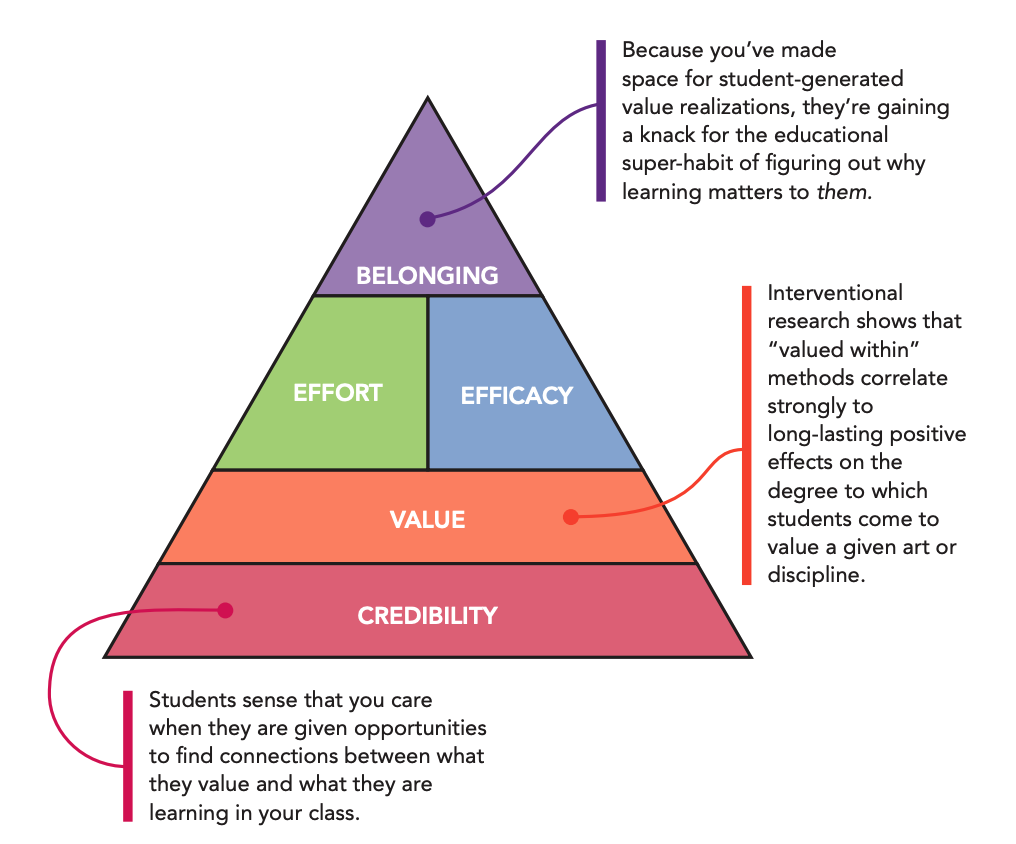In The Will to Learn: How to Cultivate Student Motivation Without Losing Your Own, I lay out an approach to student motivation in which Five Key Beliefs can be influenced using just 10 basic strategies.
The sixth of those strategies is Valued Within Exercises.
What is it?
- It's any exercise that gets students thinking about why their coursework matters (Valued) to them (Within). You will find several specific examples (e.g., the t-chart, Why Conversations, etc) in the sections that follow.
How does this strategy influence the Five Key Beliefs?
While the Valued Within strategy is found in the Value chapter of The Will to Learn, it has an influence on other beliefs as well.

Specific Examples of Valued Within Exercises
Here are some examples of Valued Within exercises. The key in looking at these examples is to notice that, in each case, students are being given the task of determining why the work matters. They are thinking their way into Value.
- Once per month, do a utility-value “t-chart” intervention. I explain this exercise here and have some tips on making it better here. I go into greater detail on pp. 160-163 of The Will to Learn.
- Here's a recent article I wrote on this strategy.
- Create “Why Conversations” with your students. Pose a scenario to your students in which a person from the street walks into the classroom and starts ranting about how your class is pointless. “World history is pointless. You don't need it in life.” Or “High school math is a complete waste of time. I've never used a single thing I learned in Algebra.” Ask your students to respond to this person via quickwrite or Think-Pair-Share or even a Pop-Up Debate.
- Here's a recent article I wrote on this strategy.
- Give your students a “find our class in the world” homework assignment. Adam Craig is a math teacher in Massachusetts who gives his students the same homework assignment every weekend: Go find a “mathy moment.” On Mondays, he asks his students to report on what they found. Within a month or so, students in class will roll their eyes when one of their peers says, “I couldn't find one.” They'll say things like, “C'mon, did you have to be anywhere on time? Did you buy something at a store? Did you alter your car's speed at a stoplight? Those are all mathy moments, dude!”
- Here's a recent article I wrote on this strategy.
- At the end of a unit, have your students self-identify “the most interesting [concept, skill, topic] from the unit.” I like to use prompts like this for end-of-unit Pop-Up Debates. It helps with content review, public speaking practice, student engagement…and with Valued Within.
- Here's a recent article I wrote on this strategy.
Still got questions?
If you ask a question in the comments section below, I'll answer it and incorporate your question into this article. In other words, you'll get a double whammy: you get your question answered, and you help make this article better for future readers.
Teaching right beside you,
DSJR
Leave a Reply